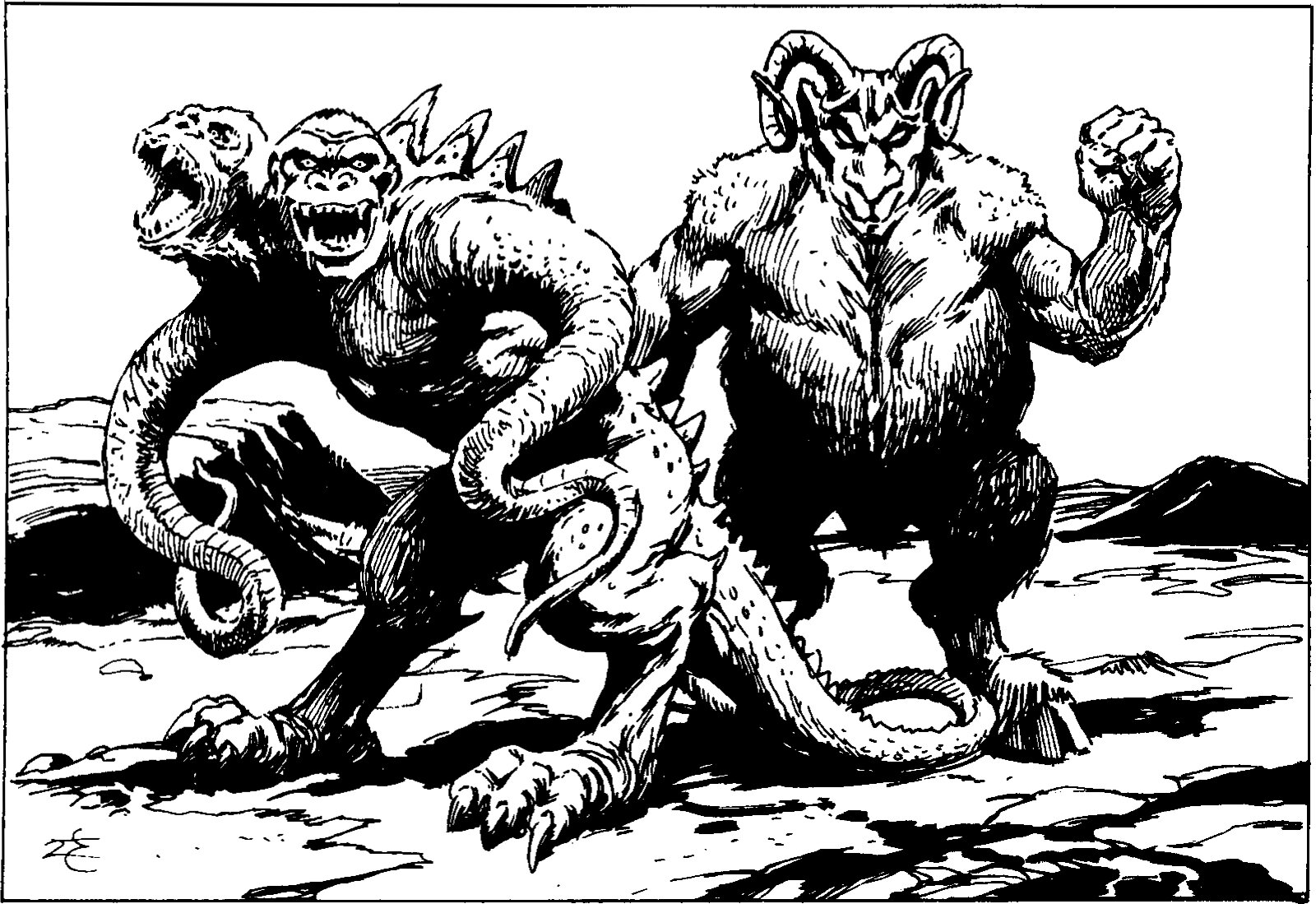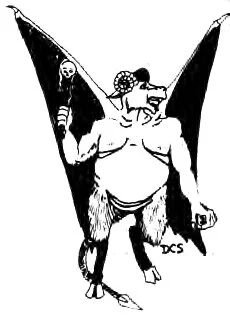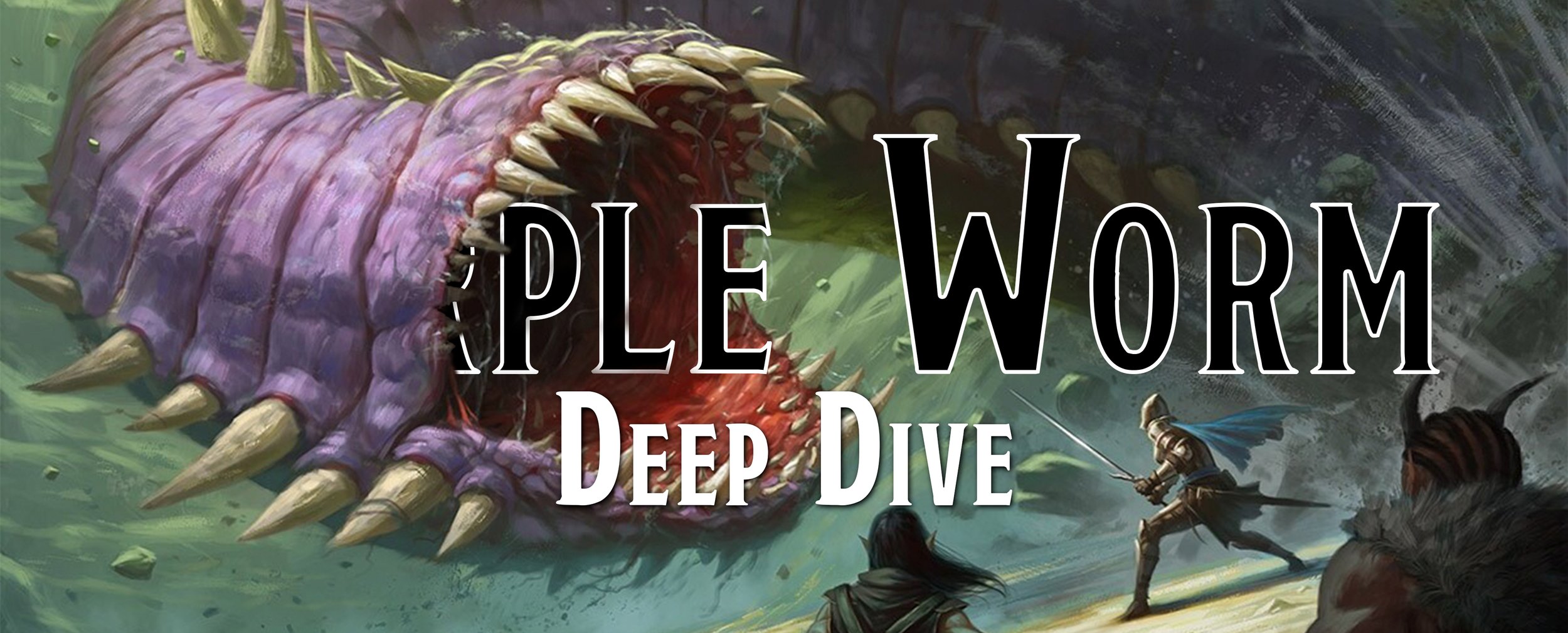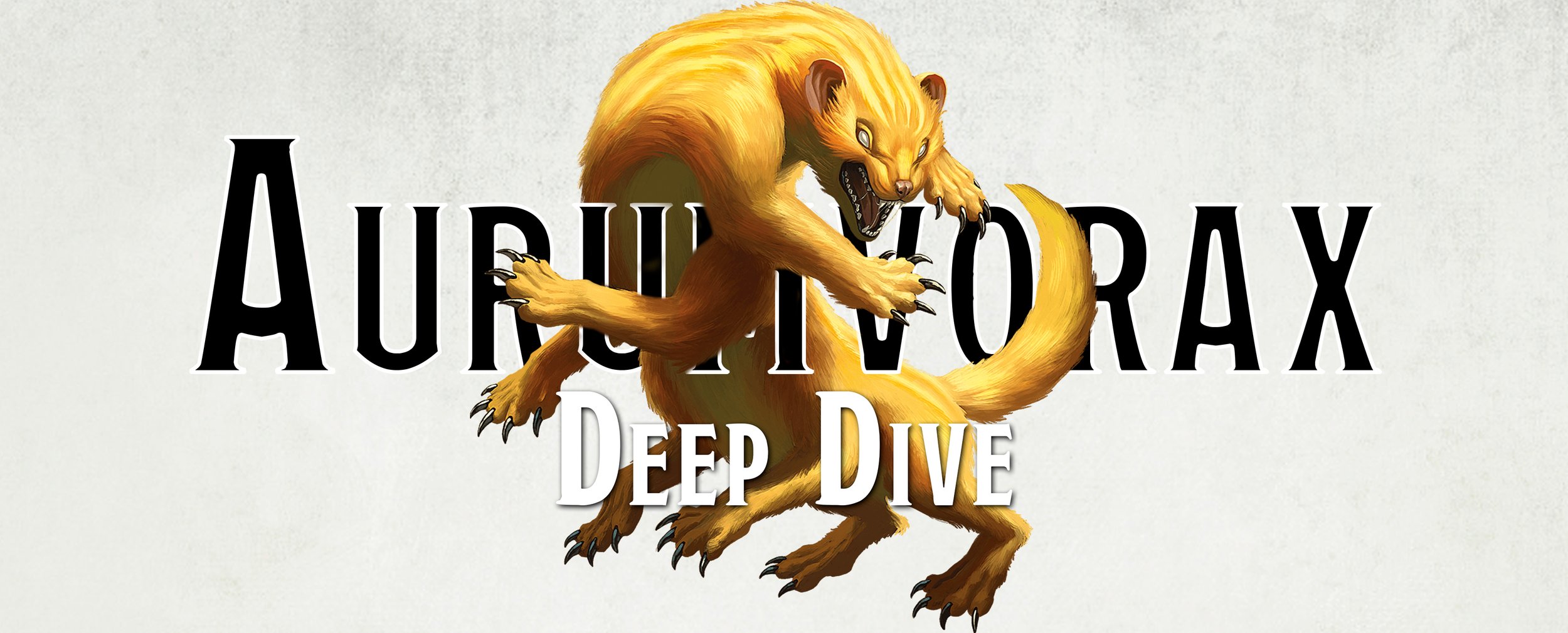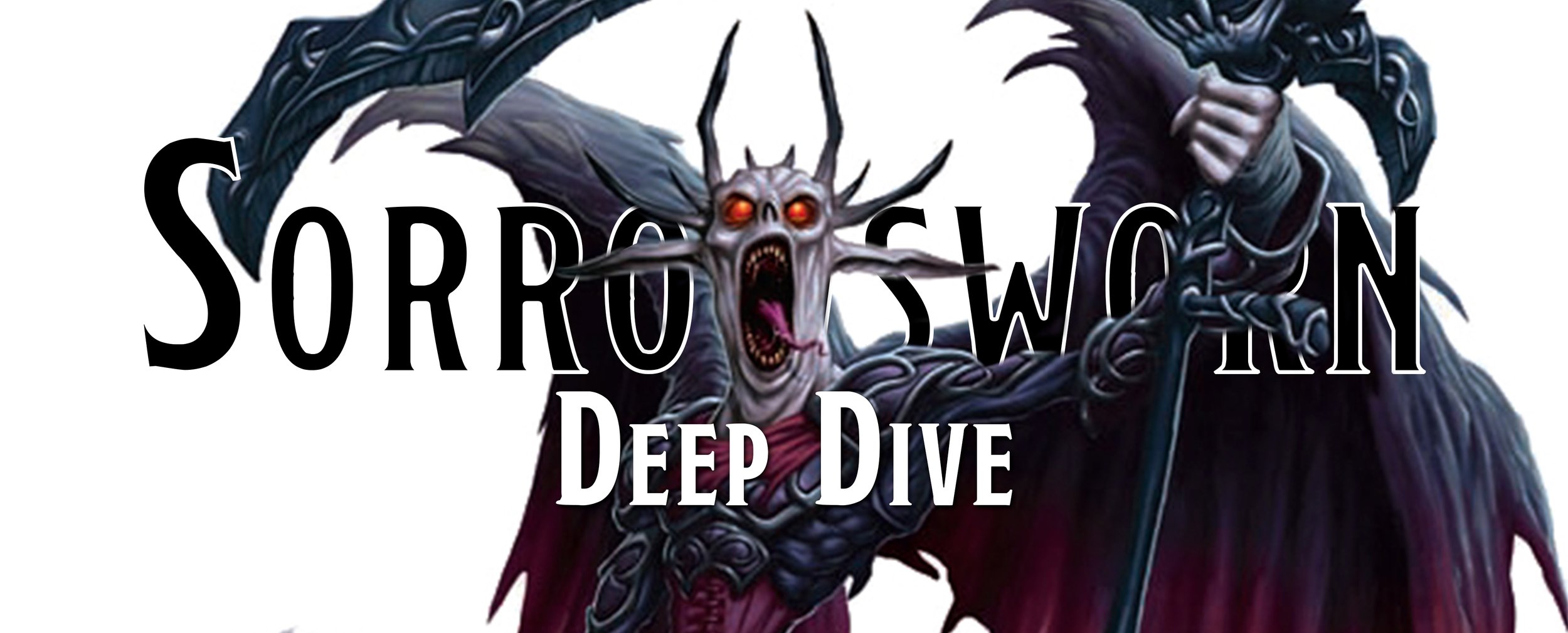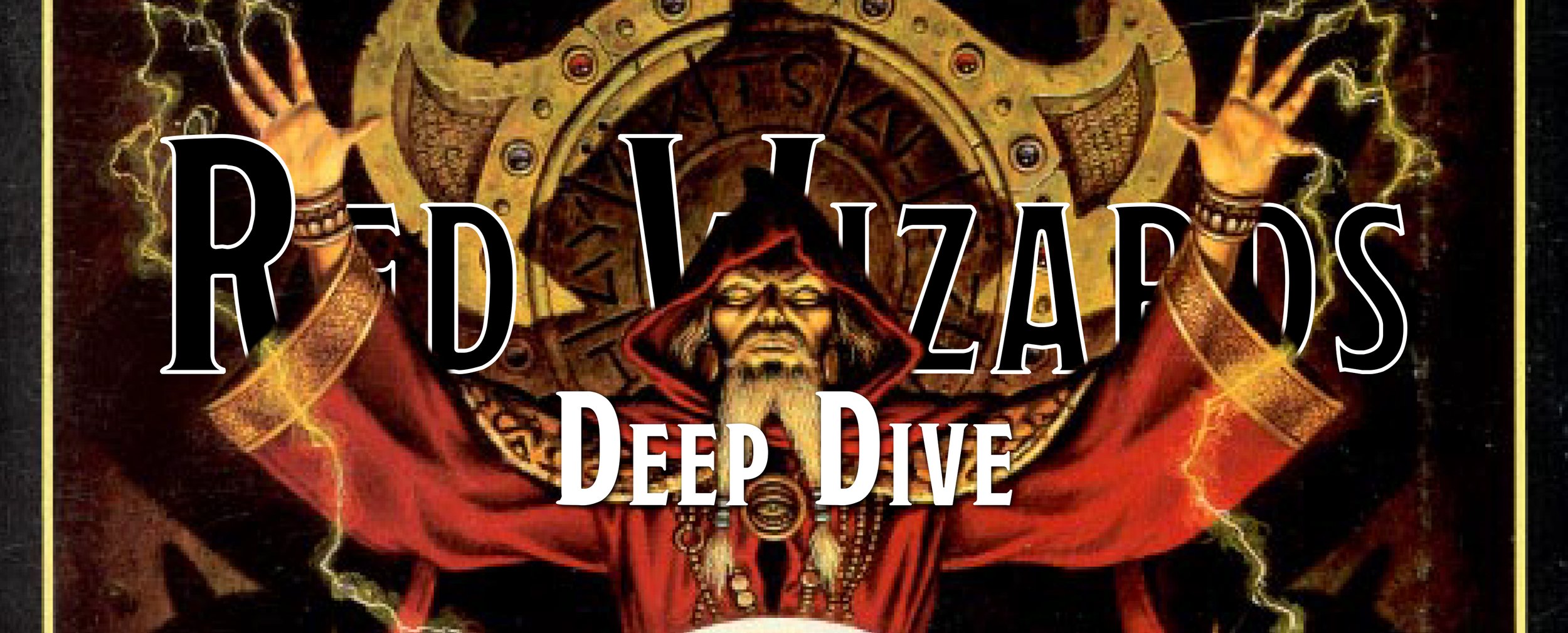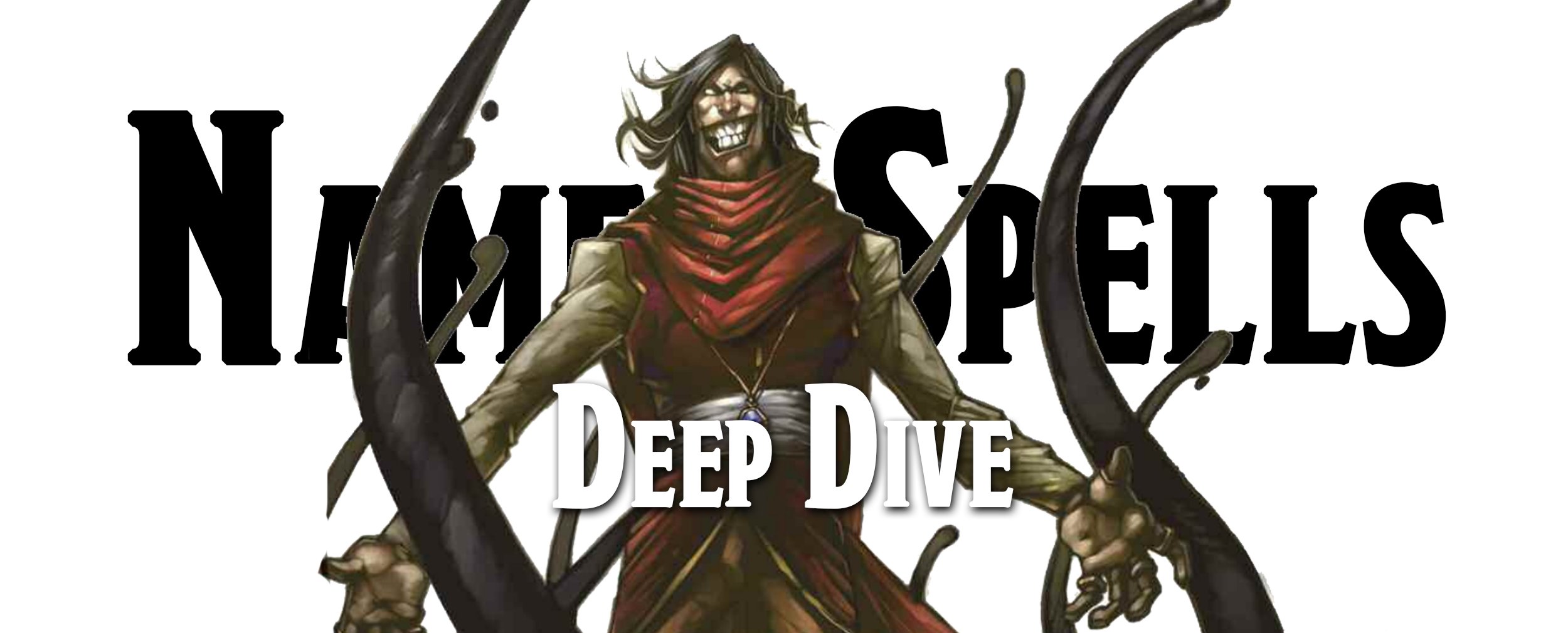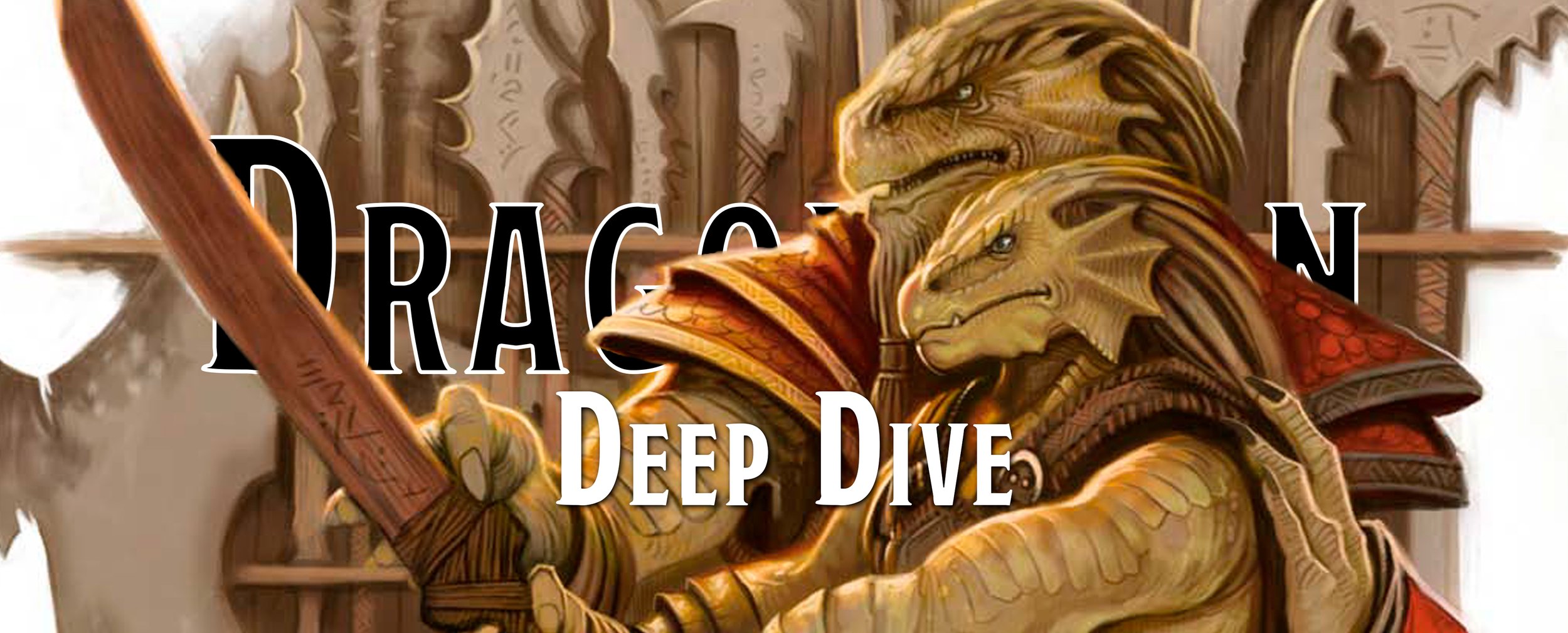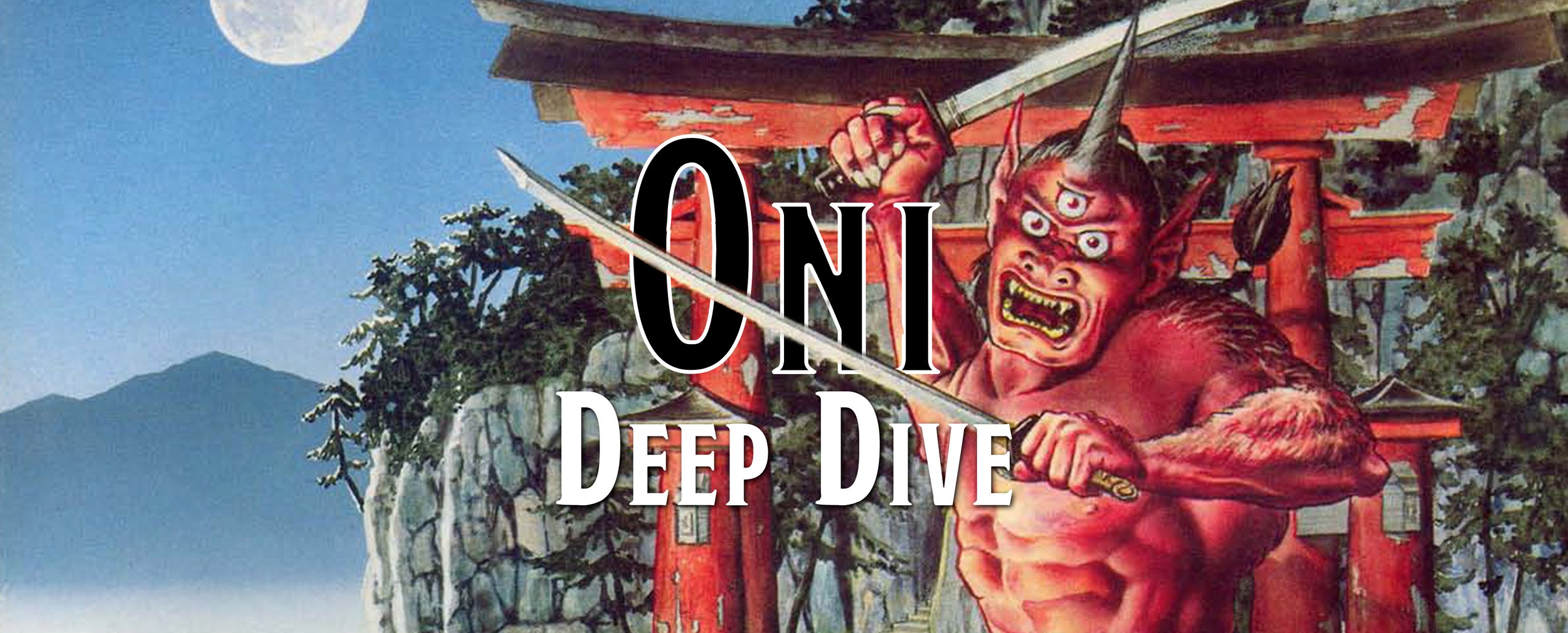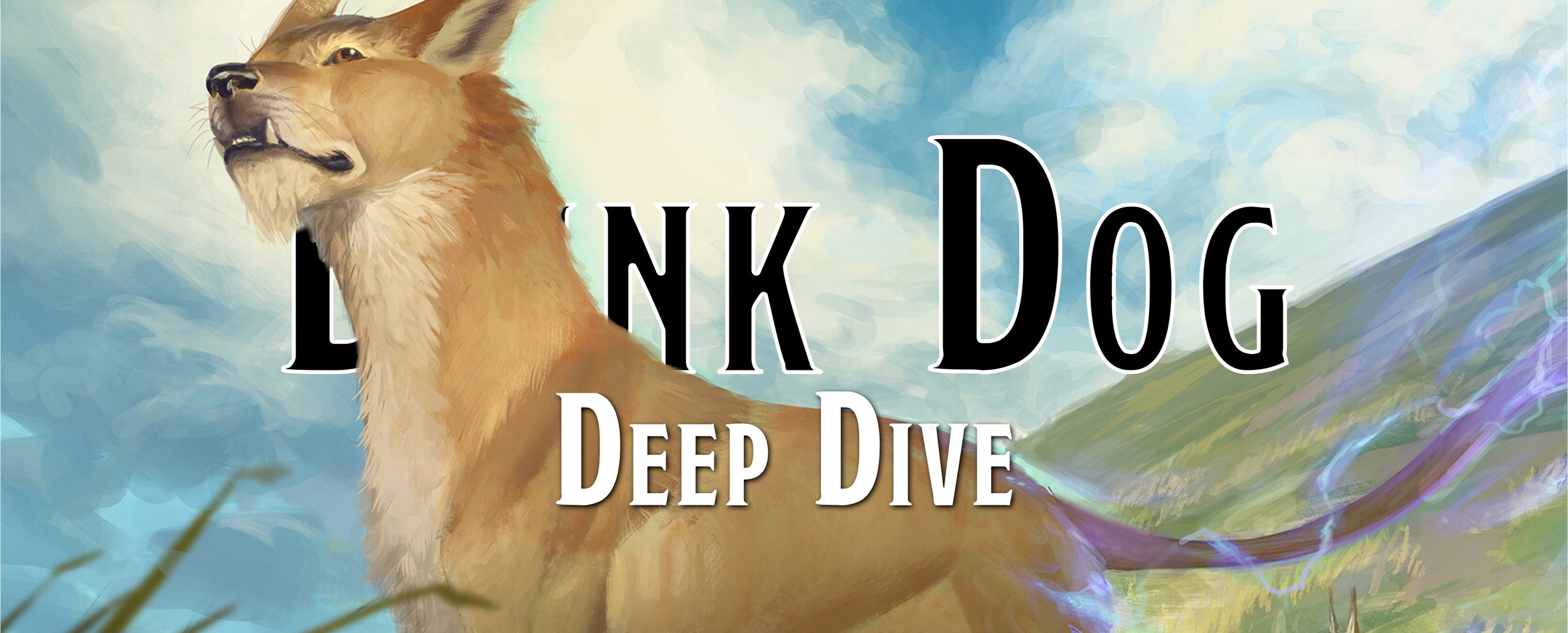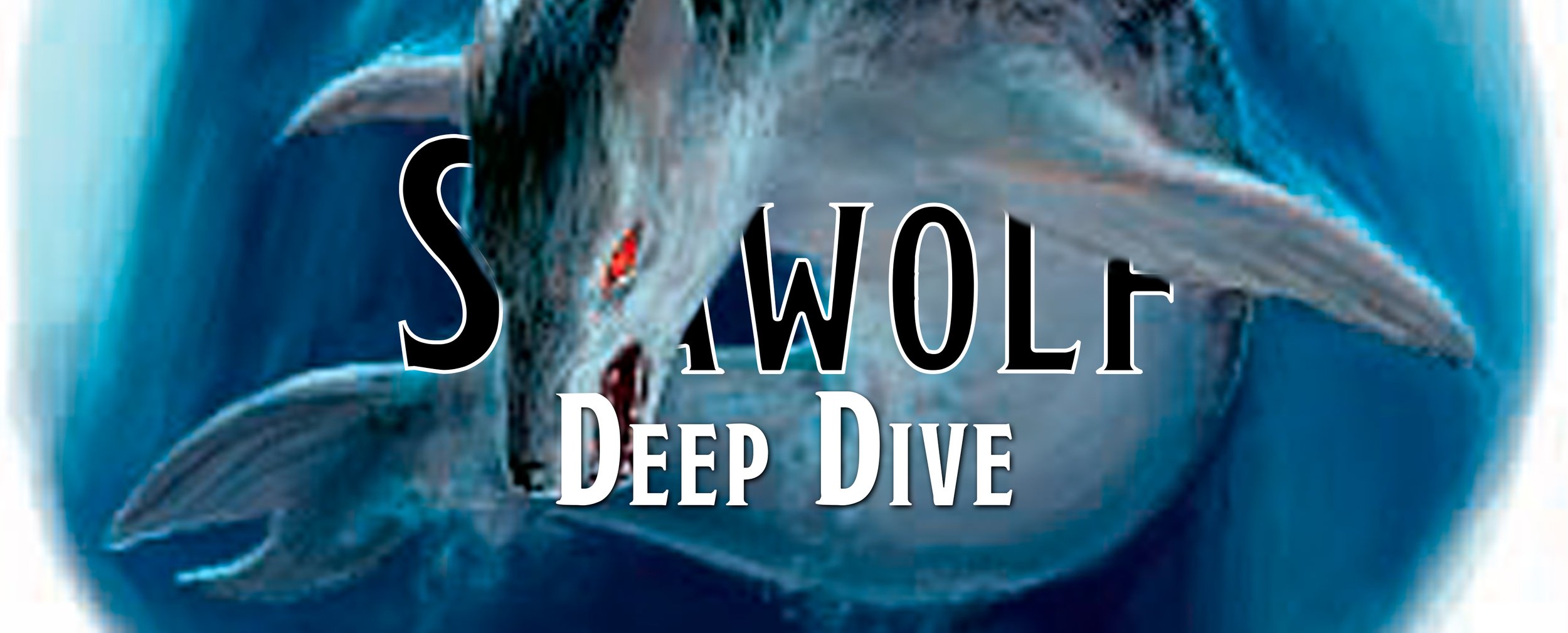Deep Dive - Orcus
Thanks to the TV series Stranger Things (2016), everyone knows Demogorgon. But what about the other original demon lord, Orcus? Arguably the more famous of the two demon lords, Orcus has never been a creature that any hero in their right mind has gone looking for.
Originally a vile mortal whose dastardly deeds resulted in his death, his soul then manifested upon the Abyss as a larva, and the long trek to demon lord began. Slaving away throughout centuries under the cruel command of ancient, and now dead, demon lords, he eventually managed through sheer will to evolve from a larva, to a mane, rutterkin, nalfeshnee, and finally a balor. Unhappy with just that, Orcus conquered the 113th layer, becoming the great demon lord we know today.
Ruling from the Abyss, Orcus lived, died, and was reborn as an undead god. Not bad for an overweight demon that was banished from Dungeons & Dragons in the 1980s. A being of immense power, not only is this creature virtually unstoppable, but he wields a wand bearing his name that can obliterate you with a touch. How has this magnificent lord of evil changed throughout the editions?
No. Appearing: 1
Armor Class: -6
Move: 9”/18”
Hit Dice: 12†
% in Lair: 75%
No. of Attacks: 2
Damage/Attack: according to weapon****
Treasure: Type E, F, G**** Orcus can employ many different weapon types, one at any given time, hit probability and damage +3; his poison tail has standard hit probability, but saving throws against his poison are at –4
† can hop double distance every other turn
Eldritch Wizardry, 1976 TSR Inc.
Orcus’ beginnings start in Supplement III: Eldritch Wizardry (1976) and let’s start with the obvious; you don’t screw with a demon lord. Orcus was everything you pictured when you thought of a demon lord and then some. Incredibly obese, Orcus is over 15 feet tall with a goat faced head and ram horns. His body is covered in thick and tough goat hair, and from his back are two large bat wings with a long serpent-like tail with a poison-tipped spike on the end. While his arms were human in shape, Orcus’ legs were that of a goat, and if we had to guess, he probably smelled like a goat too.
Orcus is the prince of the undead and could summon many of these creatures at will. A prince among demons doesn’t get its hands dirty unless it really wants to, so Orcus could summon wights, wraiths, specters, and even vampires to do his bidding. Unfortunately for you, that probably entails killing you and your friends slowly while he watches with glee. If Orcus kills and decides he wants to torment you a bit more, he could mock you in death as he can cast speak with the dead, which is just adding insult to injury.
If undead wasn’t enough, probably because you heard that he is the prince of the undead and brought along a cleric for good luck, he can also summon demons. While he only has an 80% chance of summoning a demon at the best of times, well, demons were no joke and even that feels a bit too dangerous for us. If he even just summoned a type III demon, they had a minimum of 8 hit dice, had armor classes ranging from 4 to -4, and a variety of abilities by type that included darkness at will, immunity to nonmagical weapons, powerful fear spells, and the ability to polymorph, all on top of its normal attacks. There is no mention of a maximum number of times per day Orcus may use this ability, leading us to believe you could be fighting several different demons for as long as Orcus desires, or until you killed Orcus which is… well…
Now let’s say you somehow manage to take out all of the Demon Lord’s minions and get to fight the big guy himself. His natural defenses are incredibly formidable, as Orcus was highly resistant to magic and had an armor class of -6, which means you aren’t hitting him unless you had a +3 or greater weapon. If you think those items are rare in the 5th edition, they were nearly impossible to find in the earliest editions. As you were trying to figure out how to draw blood from Orcus, he was probably using one, if not more, of its special abilities. Those abilities include a ton of spells like feeblemind, polymorph, lightning bolt, wall of fire, animate dead, and far more.
If you are still feeling confident by the end of your turn in a fight with him, well you won’t feel confident for much longer. Orcus wields a powerful obsidian wand with a skull on top, which is known as the Wand of Orcus. Unless you were a godling, a demon lord, or some other massively powerful creatures, which you never were in this edition, you should just give up now while you still have your soul. A single touch from this instrument of destruction renders the creature dead at the very least and annihilated into a small pile of ash at the worst. It had other powers in case you were worried, like allowing Orcus to heal himself or even to move at double his normal speed. Who needs a sword when you have an artifact of insane power that you named after yourself?
Now Orcus, like other demon lords, did have one weakness. Its soul was kept in a small amulet that housed Orcus’ soul to protect him from permanent death. Of course, this also makes them quite vulnerable, sort of. First one must find the amulet which was incredibly hard since it was often hidden in plain sight, could look like anything, and was non-magical. Orcus was known sometimes to wear his around his neck, but it was not required, as it was for the lesser princes. If you managed to possess the amulet, you had control over Orcus for a maximum of 24 hours, after which you lost all control over them and you better be quick in destroying it. If you destroyed the amulet, it would banish Orcus, or the demon prince it belonged to, to the Abyss for a whole year. Which doesn’t really seem like a long enough time for you to live out the short remainder of your life for demons are rarely the forgiving type. Regardless of how you used the amulet or if you destroyed it, Orcus would remember you and plot your demise. You could offer up an incredible bounty of riches and lavish Orcus with flattery of the highest praise and then, just maybe, Orcus may only kill you in 10 years or so.
Sphere: Entropy
Status: Eternal
Power Points: 9,500
Anti-Magic: 85
Armor Class: -7
Hit Dice: 39*
Hit Points: 620
Move: 90’ (30’), Flying 180’ (60’)
Attacks: See below
Damage: See below
No. Appearing: 1 (unique)
Save As: Eternal 4
Morale: Special
Call Other: Special
Treasure Type: E, F, G, I
Alignment: Chaotic
XP Value: 6,825,500 (682 PP)
BECMI Immortal Rules Box Set, 1986 TSR Inc.
There is little mention of Orcus in this edition, but he does finally show up in the BECMI Immortal Rules Box Set (1986). Orcus gains a huge number of names in this edition, like The Goat, Master of the Dead, Lord of Darkness, or the Black Prince, and even Masauwu, the Legendary Guardian of Death. He is a 4th level Eternal, putting him a step below Demogorgon, although many consider him to be Demogorgon’s equal. Along with Demogorgon, Orcus ruled the sphere of entropy. What is the sphere of entropy and what is a 4th level Eternal?
Four spheres govern almost all of existence, those sphere being: matter, energy, time, and thought. The fifth sphere is called entropy, and it serves as a balance for the other spheres. Entropy in the real world is the absence of order or predictability, leading to the gradual decline of everything into disorder. For our purposes, the sphere of entropy is the name for any changes leading to reducing the essence of the other spheres. Basically, everything eventually ends, and the whole process is the domain of the sphere of entropy. Our demon-filled sphere takes what the four Spheres give or create and breaks it down and destroys it. No wonder it is filled with demons.
A 4th level Eternal is just one of the rankings in this book and helps the reader understand who is more powerful between creatures. In this example, Orcus is only a 4th level Eternal, whereas Demogorgon is a High Eternal, or a 5th level Eternal. Only a few experience points above Orcus. There are other classifications, like Empyreal, Hierarchs, and more, just know that there are only six levels above Demogorgon, and seven above Orcus, until you hit max level in this ruleset.
Orcus remains the same in appearance, although looking at the picture of it in the text, we think he may have lost a little weight… and his wings. He stands 15 feet tall, remains a chunky goat-like humanoid, with two great curled ram's horns, human arms, and goat legs. While it no longer has giant bat wings on its back, the stats give him a fly speed, so maybe now he soars through the air like Superman. His tail is much deadlier as those who are stung by it, and fail their saving throw, lose 1 Hit Die forever and with that, every power, ability, hit points, etc. that comes with it, Orcus then gains that power if he is down any points.
Orcus continues to reign over all undead mortals and even has a few Immortals who follow him. Since he is a demon, he gains a long list of abilities, which doesn’t change from the previous edition and are about what you might suspect. Resistance to magic, speak any language, regeneration, moving between the different planes of existence, and more. Also, Orcus has all the standard abilities and immunities of other demons, but he’s also immune to poison, paralysis, turn to stone, and fear. Orcus can even polymorph into pretty much anything, like a goat. You’ll still need a +3 or better weapon even to scratch him, but you’ll probably have one by now if you're also an immortal and your DM has decided you have to fight this horrible creature. Finally, Orcus can choose to summon demons, undead, more undead, maybe a few of his immortal followers, and more. If you’re brave, or stupid enough, to search out the Lord of Darkness, be prepared for a long and arduous fight.
Frequency: Very rare
No. Appearing: 1
Armor Class: -6
Move: 9”/18”
Hit Dice: 120 hit points
% in Lair: 50%
Treasure Type: P, S, T, U
No. of Attacks: 2
Damage/Attack: 1-3/2-8
Special Attacks: See below
Special Defenses: See below
Magic Resistance: +3 or better weapon to hit
Intelligence: Supra Genius
Alignment: Chaotic Evil
Size: L (15’ tall)
Psionic Ability: 350
Attack/Defense Modes: All/all
Monster Manual, 1977 TSR Inc.
Orcus appears in the Monster Manual (1977), and his title is now Demon Lord and Prince of the Undead. He is shown the proper respect, recognized as the most powerful of all the Demon Lords in existence, in your face Demogorgon. While there are very few changes, we are given a bit more detail, which is worth reviewing.
Orcus is so powerful that the text talks about how he can lazily slap people around, and still kill them in a blow or two. Or if someone, probably you, have annoyed him enough he can begin trying and just obliterate you with punches and can even use weapons if he gets bored with punching the wizard’s head off. Once he decides he wants to relax, he can just use his tail to inject you with poison, and unless you make your saving throw with a hefty penalty tacked on to it, you just die. Poison in 1st edition, for monsters, was a save or insta-death affair, so Orcus isn’t unique in his incredibly potent poison. To put some perspective on it, if a fighter is hit by the poison, they just need to roll a 7 or higher on a d20, clerics require a 6 or higher, while magic-users and thieves need a 12 or higher or they get to make a new character.
If you still feel pretty confident that you’ll survive messing with Orcus, probably because you are a fighter and have hundreds of soldiers under your command. Well, Orcus doesn’t care too much about your hoard of level 0 soldiers as he can summon undead minions like skeletons, zombies, shadows, and vampires. To top it all off, he can still bring in demons to help kill off everyone in case the undead decide to take the day off.
The wand of Orcus is shown off in the Dungeon Master’s Guide (1979) where it is described as the ghastly weapon of Orcus. It allows him to travel the planes and so long as it is in his hands, he can boop people with it and immediately annihilate them… unless they are gods, demon lords, or other powerful beings.
H4 - The Throne of Bloodstone, 1988 TSR Inc.
In module H4 - The Throne of Bloodstone (1988), Orcus is the focal point in the series’ culmination though his priests and temples have been a focus through the previous three modules in this series. This specific module is recommended for characters levels 18-100. Yes, level 100. You’ve pretty much ascended to godhood at that point, and it’s a good thing too since you'll be traveling to the Abyss, fighting hordes of demons, and taking on Orcus himself. Your primary goal is to steal his wand and return with it to the Seven Heavens of Mount Celestia. First, you must find a portal in the citadel of a creature known as the Witch King, then travel to the Abyss, find your way to Orcus’ castle on the 333rd level, and then you can finally meet up with Orcus. Along the way, you may run into just about any demon lord you can think of, from Jubilex to Graz’zt to Lolth. You can even meet up with Demogorgon, who might help you with your quest since he’s been locked in a war with The Goat for over 100 years. You’ll find out that Orcus has captured Baphomet, has a tarrasque for a neighbor, and lives in a stupidly big fortress made of bones. Orcus’ stat block is adjusted in its fortress, and let’s just say it’s not to the player’s benefit. It is a bit ridiculous that, even with all his enhanced abilities that the module states that Orcus won’t use his wand, since you know, a single touch kills you. But that’s ok since he still has a plethora of other ways to kill you, like slapping you to the ground and then stabbing you with his tail over and over.
In Dragon #42 (October 1980), we are presented with Orcus’ favorite horse, Hacamuli. It is actually one of the many messengers of the Demon Lord and it appears as a pale, gaunt horse covered in flies and pestilence. Its eyes are black as night, and those that gaze are drained of three levels of life, we can only assume that these are the most intense puppy dog eyes.
Things get weird in the 2nd edition. Demons and devils were banished from the textbooks in the wake of the Satanic Panic of the early 1980s. You can read more about this event here and here. In response to this insane issue, the writers at TSR simply removed the creatures that could be associated with hell, satanic rituals, and demon worship. When demons and devils did make their return, they were called the tanar’ri and the baatezu, respectively. This doesn't mean that Orcus disappeared forever, as the excitement eventually died down and Orcus, along with other demons and devils, slowly crept their way back into the game.
Orcus makes his glorious return though it takes far longer than it should, especially since Demogorgon rises in 1992 in the Monster Mythology book. The Lord of Darkness has a rough start and doesn’t show up until Hellbound: The Blood War (1996), and it is announced that Orcus had been slain by Kiaransalee, a drow demi-goddess of undeath. Later, it is confirmed in On Hallowed Ground (1996), that Orcus is dead and it covers the 113th layer of the Abyss, which is called Thanatos, the Belly of Death. The description of this layer mirrors that of the 333rd layer of the Abyss mentioned in the H4 module from the 1st edition, and so it has had a slight number change. Of course, Kiaransalee is still the undead drow goddess to blame as she dispatched the former Abyssal lord of the undead, casting him into the Astral Plane, and taken over his lands of Thanatos.
The Great Modron March, 1997 WotC
It’s not until The Great Modron March (1997) that Orcus begins his epic comeback, but that is all hushed up in the background, with even the DM being left partially in the dark until the next adventure is released. In Dead Gods (1997), we get the entire story of his death and resurrection, and it is a lengthy saga of revenge and trickery.
Orcus was for sure killed by Kiaransalee, who proceeds to take over Thanatos, kill his followers, and hides the Wand of Orcus in a place where she thinks it will never be found, the bottom layer of Pandemonium in a bunch of unreachable stone. Orcus doesn’t remain dead and comes back as an undead godling, taking up the name Tenebrous. Tenebrous plots and schemes to take back Thanatos, but must first begin plotting as he is now incredibly weakened by his brush with death. Eventually, he discovers the Last Word, a declaration that has the power to destroy gods who hear it. The one final item Orcus needed to complete his comeback was his wand. In the process of hunting for the wand, he kills the supreme modron, Primus, and unbeknownst to the other modrons, takes up his position as ruler. He then forces the events that lead up to an early modron march detailed in The Great Modron March adventure anthology, and during this march, the modrons discover the two drow who hid Orcus’ wand. The character’s role in this adventure is simple, find and destroy the wand before Tenebrous catches up to you and kills you. Seriously, Orcus isn’t given a stat block, the DM is just told that if Orcus finds the party before they destroy the wand, he kills them, end the adventure there, there is no fighting Orcus even when he is so weak that a demi-god is stronger than him, that even weakened, he can kill any mortal that would face him.
Dead Gods, 1997 WotC
Large Outsider (chaotic, evil, extraplanar, tanar’ri)
Senses darkvision 60 ft., true seeing; Listen +34, Spot +34
Languages Abyssal, Common; telepathy 300 ft.
Armor Class 48, touch 20, flat-footed 42 (–1 size, +6 Dex, +28 natural, +5 deflection)
Hit Dice 26 HD, 455 hit points; DR 20/cold iron and good
Initiative +10
Immune ability drain, critical hits, death effects, electricity, energy drain, mind-affecting spells and abilities, negative energy, paralysis, poison, sneak attacks
Resist acid 10, cold 10, fire 10; SR 35
Fort +28, Ref +21, Will +20
Speed 20 ft. (4 squares), fly 40 ft. (average)
Melee Wand of Orcus +44/+39/+34/+29 (2d6+18/19–20 plus 2d6 unholy plus 2d6 chaotic plus death) and claw +35 (1d6+6) and gore +35 (1d8+6) and sting +35 (1d6+6 plus poison)
Space/Reach: 10 ft./10 ft.
Base Attack/Grapple 26; Grapple +42
Special Actions summon tanar’ri, summon undead
Spell-Like Abilities (CL 20th): At will—astral projection, command undead (DC 18), desecrate, detect good, detect law, enervation (+31 ranged touch), greater dispel magic, greater teleport, telekinesis (DC 19), unhallow, unholy blight (DC 18). 3/day—quickened enervation (+31 ranged touch), finger of death (DC 23), symbol of death (DC 24). 1/day—wail of the banshee (DC 25)
Abilities Str 35, Dex 23, Con 37, Int 27, Wis 20, Cha 19
SQ tanar’ri traits
Feats Dark Speech*, Greater Spell Focus (necromancy), Hover, Improved Critical (heavy mace), Improved Initiative, Multiattack, Quicken Spell-Like Ability (enervation), Spell Focus (necromancy), Weapon Focus (heavy mace)
Skills Bluff +33, Climb +41, Concentration +42, Craft (alchemy) +37, Diplomacy +8, Escape Artist +35, Forgery +37, Intimidate +35, Knowledge (arcana) +37, Knowledge (religion) +37, Knowledge (the planes) +37, Listen +34, Search +37, Sense Motive +34, Spellcraft +39, Spot +34, Use Magic Device +33
Possessions Wand of Orcus
Poison (Ex) Sting—Injury, Fortitude DC 36, 1d6 Str/2d6 Str. The save DC is Constitution-based.
Summon Tanar’ri (Sp) Once per day, Orcus can automatically summon 1d6 vrocks, 1d4 glabrezu, or 1 marilith. This ability functions as a 9th-level spell (CL 20th).
Summon Undead (Sp) Once per day, Orcus can automatically summon 4d10 wights, 1d8 spectres, or 1d3 mohrgs. This ability functions as a 9th-level spell (CL 20th).
Wand of Orcus The weapon that Orcus wields functions as a +6 unholy anarchic heavy mace. If the wand touches any nonoutsider, or any outsider with less than 15 HD, the target must succeed on a DC 25 Fortitude save or be instantly slain. This is a necromantic death effect. The wand also confers a +5 deflection bonus to the Armor Class of its wielder.
Orcus first appears in the 3rd edition of the Manual of the Planes (2001), and the return of Orcus, or should we say Tenebrous, is expanded upon a little further. When under the moniker Tenebrous, Orcus killed rival gods using the all-powerful Last Word. Orcus found and restored his wand, which allowed the demon to begin a resurrection spell with the help of a faithful servant, the half-ogre Quah-Namog. As adventurers do, they found out about the ritual, swooped in at the last second, and stopped the ritual from being completed. While Orcus did not return at full strength, the ritual was enough to bring him back to life. Besides, the drow deity that originally evicted Orcus from Thanatos is now missing, with many presuming she is dead. Some believe Orcus has now returned to Thanatos and rules it yet again, though very few people are willing to travel the Abyss to find out, and far fewer would ever return from such a trip.
Book of VIle Darkness, 2002 WotC
In the text Book of Vile Darkness (2002), Orcus continues his glorious return and the book confirms that he has retaken Thanatos and rules in the city of Naratyr. Of course, there is no rest for the Lord of Darkness and he is immediately back at war against Demogorgon and Graz’zt, attempting to take over their realms and destroy them with his massive army of undead and demons.
While some may know him as the Prince of the Undead, Orcus hates the title, mostly because he hates the undead and sees them only as tools. It probably doesn’t help that many view him as undead-adjacent and he doesn’t like to remember how that one time he got so lazy that someone was actually able to kill him. Intelligent undead, like liches or vampires, won’t worship or venerate Orcus due to his hatred, but that doesn’t bother him in the least. Compared to the other demon lords, Orcus gets the most worship out of all of them, normally from cultists also looking to use undead for their ends and to get some of his power for themselves.
Sometimes, Orcus will relinquish his wand, referred to as a rod, to the world, allowing his cultists to wreak havoc across the world. After a year or two of this, the wand probably switching hands several times, Orcus will call back his wand, and probably the soul of whoever was holding it last so that he has something to play with back in the Abyss. Of course, if you do get this wand, it is quite powerful so we can understand why some people might look at it and think that that was their key to ultimate power and not a way to get Orcus interested in your soul.
The wand of Orcus acts as a powerful mace when wielded in battle, when it touches mortals or weak creatures from the Outer Planes, then it has the chance to immediately kill them. Even the wielder of the wand is in danger as Orcus can just decide that anyone touching his wand right now should die, their soul ripped away and handed to the demon prince who hates to share his toys. Also, the wand can be used to cast a few spells all focused on pain and death, like abyssal might, clutch of Orcus, and other strange spells.
Orcus has legions of followers, priests, and cultists that worship him. Two of the most powerful are the priest Quah-Nomag the Skull King and Orcus’ primary enforcer, the vampire Kauvra. You may recognize Quah-Nomag as the individual that resurrected Orcus, and we aren’t sure whether to thank him or curse his name. Now, if you are captivated by the power of Orcus, you can become a worshipper and gain access to the prestige class Thrall of Orcus. The Demon Lord grants these followers special powers like carrion stench, demon wings, death touch, and the ability to summon greater undead. Is it worth giving up your mortality to Orcus? Probably not, but you’ll never know until you try.
Libris Mortis: The Book of the Undead, 2004 WotC
Orcus gets a little bit more information in Libris Mortis: The Book of the Undead (2004), and some of it is even a bit surprising. Orcus gets a lot of worship, especially from demons and necromancers, sometimes even undead that he hasn’t yet subjugated, and is thought to be far closer to ascending to true godhood than any other demon. While Orcus isn’t the most powerful of the demon princes, with Demogorgon thought to be more powerful, that hasn’t stopped Orcus from amassing followers and we’d be shocked if Orcus didn’t send passive-aggressive notes to Demogorgon talking about how he feels so divine and god-like, or maybe Orcus isn’t as petty as us.
In addition, we also find out that while Orcus hates the undead, he also despises the living equally. He views most creatures with revulsion and loathing, only seeking to spread misery and destruction to others all to ensure his increase in power. Despite his utter disgust at creatures, he still pulls in that worship and has temples that span the multiverse. Strongholds of the undead, warring nobles, and even entire tribes of orcs pledge their allegiance to him, which probably means we just need to get to know Orcus, that he isn’t that bad when you get to know him.
Our final book, Fiendish Codex I: Hordes of the Abyss (2006) updates Orcus to 3.5 edition, though much of the demon lord’s abilities remain the same. Orcus’ constant battles against Demogorgon and Graz’zt are given a bit more detail, only detailing the fury that Orcus feels for them. While his primary enemy is Demogorgon, who we are constantly reminded is a bit more powerful than the Prince of the Undead, Orcus really covets the vast empire that Graz’zt controls. This leads Orcus to drive his undead forces deep into the dark prince’s realm while using more subtle means of subterfuge and assassination when battling Demogorgon. Orcus may seem like the least powerful of the three, but his vast empire of loyal followers on the Material Plane dwarfs that of the other two. He uses them to help grow his power and influence, supplying him with a constant supply of undead creatures and sacrifices.
We are also provided with a detailed description of Orcus’ realm, Thanatos. It’s not a vacation spot, as the sun never appears, and the land is covered in gray clouds in a black sky. It is cold and desolate, with moss and fungi as the only plant life. Countless undead minions occupy the plane, traveling in packs on their eternal quest for flesh. You can travel to such wonderful places as the City of Straight Curves, Everlost, The Final Hills, The Frozen Sea, Orcusgate, and many others, but none of these places are bright and shiny places. Of all these places, it is the sprawling city of Orcusgate that attracts the most creatures. Demons comprise most of the population, as they are drawn there by the gate of fire connecting Thanatos to the Pits of Pazunia on the first layer of the Abyss. They are the top demons of Orcus’ cult, holding sway over access to the gate and using it themselves to travel throughout the Abyss to do Orcus’ bidding. Mortals often arrive here but quickly depart for Lash Embrar, a city ruled over by the Skull King Quah-Nomag which is quite far from Orcusgate since Orcus is tired of how self-important Quah-Nomag is getting, it is also much more hospitable to living creatures. All of this, along with the fact that the official name used on the travel brochure is Thanatos, the Belly of Death, makes it a place you don’t want to go unless you truly have to.
Level 33 Solo Brute (Leader)
Gargantuan elemental humanoid (demon) / XP 155,000
Initiative +22/ Senses Perception +28; darkvision, low light vision
Aura of Death (Necrotic) aura 20; enemies that enter or start their turns in the aura take 10 necrotic damage (20 necrotic damage while Orcus is bloodied).
The Dead Rise aura 6; enemies (including flying ones) treat the area within the aura as diffi cult terrain, and any dead creature within the aura at the start of Orcus’s turn (except those killed by the Wand of Orcus) rises as an abyssal ghoul myrmidon (page 119) to fi ght at Orcus’s command.
HP 1,525; Bloodied 726
AC 48; Fortitude 51, Reflex 46, Will 49
Immune disease, poison, necrotic; Resist 10 variable (3/encounter)
Saving Throw +5
Speed 6, fly 10 (clumsy), teleport 6
Action Points 2
Wand of Orcus (standard; at-will) ✦ Necrotic, Weapon Reach 4; +37 vs. AC; 2d12 + 12 damage plus 1d12 necrotic damage, and the target is weakened (save ends); see also master of undeath.
Touch of Death (standard; recharge 6) ✦ Necrotic Reach 4; +33 vs. Fortitude; the target is reduced to 0 hit points (resistance or immunity to necrotic damage does not apply). Miss: The target takes necrotic damage equal to its bloodied value
Tail Lash (immediate reaction, when an enemy moves or shifts into a square adjacent to Orcus; at-will) +36 vs. AC; 2d8 + 12 damage, and the target is stunned until the end of Orcus’s next turn and is knocked prone
Necrotic Burst (standard; recharge 6) ✦ Healing, Necrotic Close burst 10; +38 vs. Fortitude; 2d12 + 12 necrotic damage, and all undead in the burst regain 20 hit points.
Master of Undeath At the start of Orcus’s turn, any creature killed by the Wand of Orcus that is still dead rises as a dread wraith under Orcus’s command.
Alignment Chaotic evil / Languages Abyssal, Common
Skills Arcana +28, History +28, Intimidate +31, Religion +28
Str 35 (+28) Dex 22 (+22) Wis 25 (+23) Con 33 (+27) Int 25 (+23) Cha 30 (+26)
Equipment Wand of Orcus
Monster Manual, 2008 WotC
Found first in the Monster Manual (2008), Orcus rises in prominence and even graces the cover of the book. You don’t get that privilege if you aren’t the mightiest of the demon lords, and in fact, Demogorgon had to wait until the next Monster Manual. This fat-bellied goat demon gets a cool new title, The Blood Lord, along with the Demon Lord of Undeath and the Demon Prince of the Undead. It’s a strange combination of titles, but we’ll try to explain if we can. If you’re alive, you enrage the Blood Lord because of your very existence and it brings Orcus nothing but suffering and agony for you to be alive. If you are undead, this also causes Orcus a great amount of agony and can only be pacified when he destroys and drinks the blood of his victims. He’s a complicated demon lord, but that’s why you just have to love him.
Looking at his powerful wand, the skull that graces the top of it is now pulled into question. There are two stories behind the possible victim whose skull adorns the top of the obsidian shaft, the first being that the skull belongs to a dead god of virtue and chivalry. The god didn’t die of natural causes, but by the hand of Orcus, who probably lopped off its head, flayed the skin from it, and set it atop the wand. The second story is that the skull is that of a mere human hero, but that must have been one big-headed human since the skull is giant size. No matter the truth, The Blood Lord took the good power from the skull and twisted it into an evil that can kill any creature it touches.
In addition to the information on Orcus, we also get to look at his minions and servants. The Aspect of Orcus allows Orcus to summon a minor version of himself and to send to his followers to help in their endeavors. As for servants, Orcus has several mortal followers that are willing to serve him like the Deathpriest Hierophant, Deathpriest of Orcus, and Crimson Acolyte. The Hierophant is the most powerful of all Orcus’ priests, who can project a vision of death into the mind of its target and invoke the name of Orcus to hurt you while healing any undead around. Deathpriests have mastery over necrotic energies, while the Acolytes wield bloodstained scythes and aspire to the ranks of the Deathpriests. All these servants are members of the various cults of Orcus on the Material Plane, congregating in graveyards, tombs, and other scary and haunted areas. There are several cults, each with their own symbols and icons, although robes of black and crimson are one thing they all have in common. That, and the blood sacrifices they perform in the name of their lord, Orcus.
If you’ve ever wanted to visit Orcus, for some reason, and wish to journey to Thanatos, the Manual of the Planes (2008) provides plenty of information on what you can expect. Ash-gray clouds, blackened skies, hordes of undead thralls, and lots of demons are hallmarks of these lands and little changes from what is revealed in the previous edition. Though Orcus has abandoned his Orcusgate city for a more remote location called Oblivion’s End where his fortress, Everlost, towers over a large desert of powdered bones. This land is rather inhospitable, much to our surprise, and unless you are hoping to curry Orcus’ favor, there isn’t much here beyond Orcus and his elite soldiers.
E3 - Prince of Undeath, 2009 WotC
Orcus’ obsession with the destruction of Demogorgon and Graz’zt is reduced to a dull simmer as Orcus has now set his sights on bigger targets, like the destruction of the Raven Queen and her control over death. This hatred comes to the forefront in almost all of the adventures in this edition. The adventure series is broken into 9 modules starting with characters at level 1 and eventually culminating to 30th level, all the while the party is facing off against the forces of evil, which often, but not always, involves the cult of Orcus who are trying to help him ascend to godhood and kill the Raven Queen. This series involves the heroes jumping across the multiverse, journeying into the Abyss, the Shadowfell and the Feywild, fighting dragons, undead, and more. The main focus of the later adventure, in the E series modules which contain E1 - Death’s Reach (2009), E2 - Kingdom of the Ghouls (2009), and E3 - Prince of Undeath (2009), has the party attempting to foil Orcus’ plans. They must first break the siege against Letherna, where the Raven Queen resides, fighting against Orcus’ elite demons. Eventually, they attract the wrath of Orcus and must deal with his powerful exarch, Doresain the Ghoul King. After that, they continue messing with Orcus’ plans before they finally stop him from destroying the Raven Queen and stealing her godhood.
In The Shadowfell - Gloomwrought & Beyond (2008), Orcus’ relationship with the Raven Queen is further defined and it is revealed that Orcus is constantly trying to send spies and secret cultists to the Raven Queen’s realm to undermine her. Orcus controls huge swaths of the Shadowfell, and the shadar-kai are a constant enemy as they are loyal to the Raven Queen and see anyone who worships the demon prince as only worthy of death. To help his plans move forward, Orcus offers large rewards to any who can kill the shadar-kai and raven knights, and even greater rewards to those who bring them back alive so that Orcus can torture them.
Huge fiend (demon), chaotic evil
Armor Class 17 (natural armor), 20 with the Wand of Orcus
Hit Points 405 (30d12+210)
Speed 40 ft., fly 40 ft.
STR 27 (+8) DEX 14 (+2) CON 25 (+7 ) INT 20 (+5) WIS 20 (+5) CHA 25 (+7)
Saving Throws Dex +10, Con +15, Wis +13
Skills Arcana +11, Perception +12
Damage Resistances cold, fire, lightning
Damage Immunities necrotic, poison; bludgeoning, piercing, and slashing that is nonmagical
Condition Immunities charmed, exhaustion, frightened, poisoned
Senses truesight 120 ft., passive Perception 22
Languages All, telepathy 120 ft.
Challenge 26 (90,000 XP)
Wand of Orcus The wand has 7 charges, and any or its properties that require a saving throw have a save DC of 18. While holding it, Orcus can use an action to cast animate dead, blight, or speak with dead. Alternatively, he can expend 1 or more charges to cast one of the following spells from it: circle of death (1 charge), finger of death (1 charge), or power word kill (2 charges). The wand regains 1d4+3 charges daily at dawn. While holding the wand, Orcus can use an action to conjure undead creatures whose combined avergae hit points don’texceed 500. These undead magically rise up from the ground or otherwise form in unoccupied spaces within 100 feet of Orcus and obey his commands until they are destroyed or until he dismisses them as an action. Once this property of the wand is used, the property can’t be used again until the next dawn.
Innate Spellcasting Orcus’s spellcasting ability is Charisma (spell save DC 23, +15 to hit with spell attacks). He can innately cast the following spells, requiring no material components:
At will: chill touch (17th level), detect magic
3/day each: create undead, dispel magic
1/day: time stop
Legendary Resistance (3/Day). If Orcus fails a saving throw, he can choose to succeed instead.
Magic Resistance. Orcus has advantage on saving throws against spells and other magical effects.
Magic Weapons. Orcus's weapon attacks are magical.
Master of Undeath. When Orcus casts animate dead or create undead, he chooses the level at which the spell is cast, and the creatures created by the spells remain under his control indefinitely. Additionally, he can cast create undead even when it isn't night.
Multiattack. Orcus makes two Wand of Orcus attacks.
Wand of Orcus. Melee Weapon Attack: +19 to hit, reach 10 ft., one target. Hit: 21 (3d8 + 8) bludgeoning damage plus 13 (2d12) necrotic damage.
Tail. Melee Weapon Attack: +16 to hit, reach 10 ft., one target. Hit: 21 (3d8 + 8) piercing damage plus 9 (2d8) poison damage.
Legendary Actions. Orcus can take 3 legendary actions, choosing from the options below. Only one legendary action option can be used at a time and only at the end of another creature's turn. Orcus regains spent legendary actions at the start of his turn.
Tail. Orcus makes one tail attack.
A Taste ofUndeath. Orcus casts chill touch (17th level).
Creeping Death (Costs 2 Actions). Orcus chooses a point on the ground that he can see within 100 feet of him. A cylinder of swirling necrotic energy 60 feet tall and with a 10-foot radius rises from that point and lasts until the end of Orcus's next turn. Creatures in that area have vulnerability to necrotic damage.
Orcus is first mentioned in the Monster Manual (2014), but no stat block is provided and we only get a few paragraphs, much like all the other demon lords. Described as the Blood Lord and the Demon Prince of Undeath, his hatred of undead creatures seems to have lessened considerably as only living creatures not bound or controlled by him are anathema to his existence. It’s nice that he has finally gotten over hating everything, and now just hates most things. Sadly, little else is revealed about him beyond ghouls and wights seem to like him.
Dungeon Master’s Guide, 2014 WotC
The next drip of information comes in the Dungeon Master’s Guide (2014) which shows off his home in the Abyss, Thanatos. Still described as a horrible place, much of what is written is from 4th edition and is covered in tombs, mausoleums, and more across its landscapes, and that Orcus’ lair is still in Everlost in the wasteland known as Oblivion’s End. This book also contains the Wand of Orcus, a powerful artifact that has a magically enlarged skull, cause we guess there were no giant skulls available when Orcus was working on his art project, and it is actually rather lame. Sure you can cast a bunch of spells from it, like blight or finger of death, but its power has been shrunken considerably. It can no longer kill with a single touch, though if you pick it up and attune to it, it has the potential to kill you outright. You can summon undead with it, and for the first time, it has sentience and wishes to help Orcus’ goals, though it only acts like it likes the wielder, feigning devotion to whoever wields it. There is also some information on the skull Orcus uses on top of the wand, that it is the skull of an ancient hero and that his soul has been imprisoned by Orcus somewhere.
Orcus finally makes his true appearance in the adventure Out of the Abyss (2015), but as a minor character only, and is immediately killed in a cut scene by Demogorgon. His only purpose in this adventure is to fight Demogorgon at the end, wounding it so that the adventurers have an easier time to kill the demon lord, and is crushed beneath the tentacles of Prince of Demons. It’s a horrific tragedy for Orcus, but at least he gets a stat block at the back of the book that is quite respectable for such a powerful and well-known being. While there is some lore written in there about him, much of it is similar to what we already found out but we do learn that he actually makes his lair in the fortress city of Naratyr, found on Thanatos, and it is surrounded by a moat fed by the River Styx. Seems like, in 1 year, Orcus decided to move from Everlost and Oblivion’s End and head back to his old stomping grounds of Naratyr, this time with a large moat.
Mordenkainen’s Tome of Foes, 2018 WotC
In Mordenkainen’s Tome of Foes (2018), Orcus finally gets a bit more juicy information, and we can finally start getting his perspective on stuff. We learn that Orcus isn’t hell-bent on the destruction of the world because he hates everything in life, but because he hates all life. To him, life is noisy and messy, that it scratches at his finer sensibilities like a rat scratching through his mind. He just wants the quiet that accompanies death, and we think deep down inside each of us, we can understand that. Aren’t we all just looking for some peace and quiet?
We also get a bit more information on his cultists and those who understand what it is like to live in a cruel, living world. Orcus is revered by individuals who see the gods as the problem, that they can take away the life from loved ones and do nothing to stop death. Orcus is an attractive option, one that can offer them a respite from dealing with the pain of death through undeath. He offers to bring back those who die to undeath, and while it might be a mockery of life, it is far better than the gods who do nothing but sit there and force people to pay hundreds of gold to return the dead to life.
Those who are especially vulnerable include grieving parents, siblings, and others who have recently suffered a great loss. Those who spread his name are rewarded and are granted portions of his power. Those who just spread his name are rewarded with being transformed into ghouls or zombies who serve in his legions, while his favored servants are the cultists and necromancers who murder the living and then manipulate the dead, emulating their dread master. While it might seem a bit greedy that the Blood Lord already has countless ghouls and skeletons under his command, that the only reward he offers is to be turned into more of his mindless legions, for some, undeath is just the peace and quiet they were always looking for.
Orcus might have been misunderstood since the beginning. He is a powerful demon prince of undeath, but not only because he hates all living creatures. It’s because they are noisy and unclean, that their lives cause him physical pain. He only hopes to turn all life into undeath so that he can finally live in a multiverse of peace. The destruction of suns and stars, the destruction of light in the darkness, all these things will eventually end, and then, and only then, will Orcus finally have the rest he so rightfully deserves.
If you enjoy our Deep Dive series, consider
supporting us on Patreon and following us on Twitter!
Let us know in the comments below!


